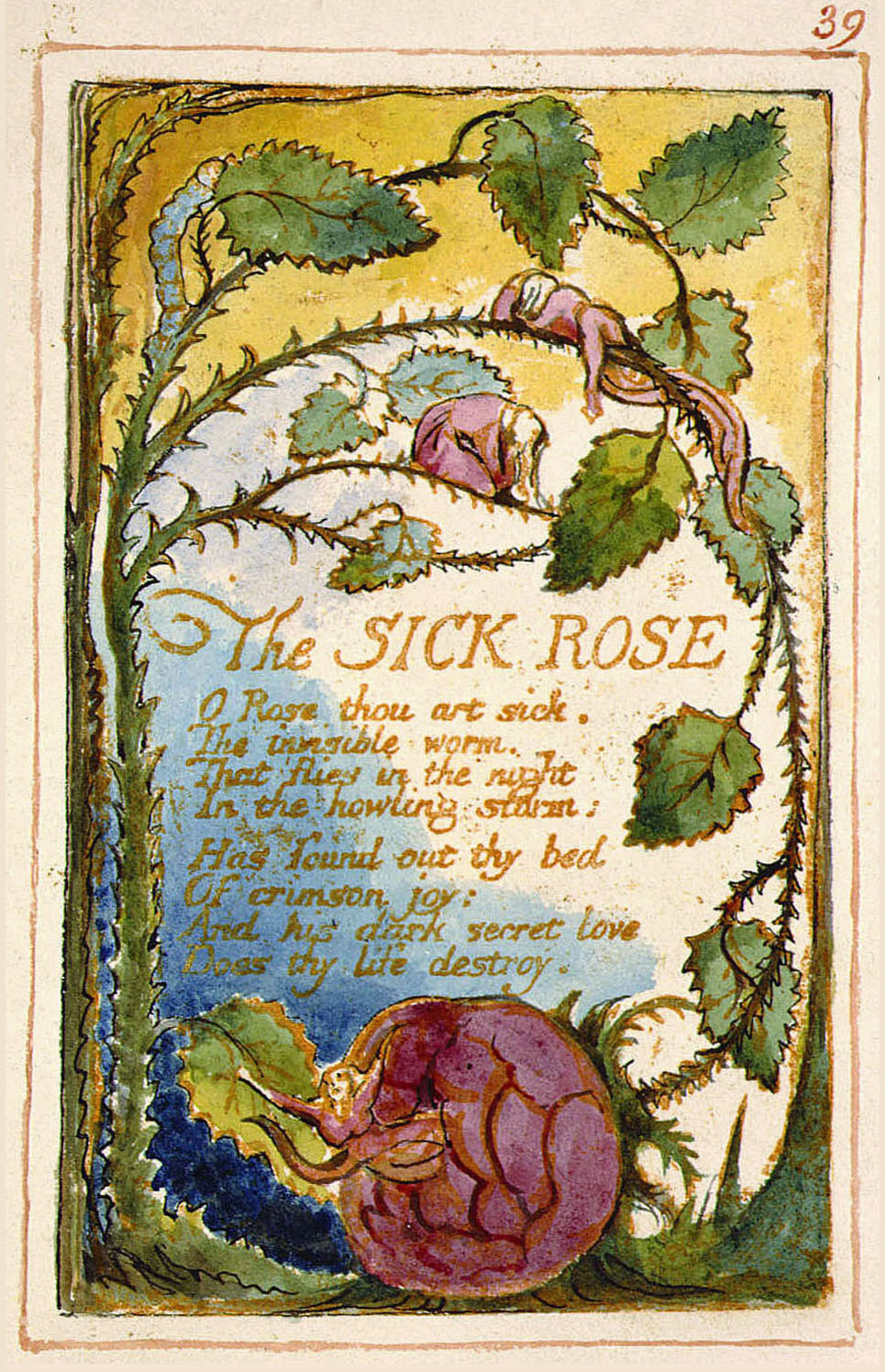The Sick Rose on:
[Wikipedia]
[Google]
[Amazon]
 "The Sick Rose" is a poem by
"The Sick Rose" is a poem by
 "The Sick Rose" is a poem by
"The Sick Rose" is a poem by William Blake
William Blake (28 November 1757 – 12 August 1827) was an English poet, painter, and printmaker. Largely unrecognised during his life, Blake is now considered a seminal figure in the history of the poetry and visual art of the Romantic Age. ...
, originally published in ''Songs of Innocence and of Experience
''Songs of Innocence and of Experience'' is a collection of illustrated poems by William Blake. It appeared in two phases: a few first copies were printed and illuminated by Blake himself in 1789; five years later, he bound these poems with a ...
'' as the 39th plate; the incipit
The incipit () of a text is the first few words of the text, employed as an identifying label. In a musical composition, an incipit is an initial sequence of notes, having the same purpose. The word ''incipit'' comes from Latin and means "it beg ...
of the poem is O Rose thou art sick. Blake composed the poem sometime after 1789, and presented it with an illuminated border and illustration, typical of his self-publications. Since the 20th century, the poem has been the subject of scrutiny by scholars for its oblique and enigmatic meaning, and bizarre, suggestive imagery.
Text
:O Rose thou art sick, :The invisible worm :That flies in the night, :In the howling storm, :Has found out thy bed :Of crimson joy: :And his dark secret love :Does thy life destroy.Analysis
Nathan Cervo describes the poem as "One of the most baffling and enigmatic in the English language". The rose and worm in the poem have been seen as "figures of humanity", although Michael Riffaterre doubts the direct equivalence of Man as a worm; when Blake makes this comparison in other places, Riffaterre notes, he is explicit about it. Nevertheless, the "lesson of the worm may be applicable to human experience". Therhyme scheme
A rhyme scheme is the pattern of rhymes at the end of each line of a poem or song. It is usually referred to by using letters to indicate which lines rhyme; lines designated with the same letter all rhyme with each other.
An example of the ABAB rh ...
is ABCB. The scansion
Scansion ( , rhymes with ''mansion''; verb: ''to scan''), or a system of scansion, is the method or practice of determining and (usually) graphically representing the metrical pattern of a line of verse. In classical poetry, these patterns are ...
is difficult to place, due to a lack of pattern; the stanzas are asymmetrical: the first has syllables of 5,6,5,5, and the second of 5,4,6,5. Punctuation is also irregular: there is no comma after "O Rose", and yet there is a comma after "worm".
The poem was set to music by Benjamin Britten
Edward Benjamin Britten, Baron Britten (22 November 1913 – 4 December 1976, aged 63) was an English composer, conductor, and pianist. He was a central figure of 20th-century British music, with a range of works including opera, other ...
in his 1943 ''Serenade for Tenor, Horn and Strings
The ''Serenade for Tenor, Horn and Strings'', Op. 31, is a song cycle written in 1943 by Benjamin Britten for tenor, solo horn and a string orchestra. Composed during the Second World War at the request of the horn player Dennis Brain, it is a ...
'', where it forms the movement "Elegy". British band Amplifier
An amplifier, electronic amplifier or (informally) amp is an electronic device that can increase the magnitude of a signal (a time-varying voltage or current). It may increase the power significantly, or its main effect may be to boost the v ...
set the poem to music on their 2011 album '' The Octopus''. Verses of the poem also comprised and inspired the 1991 song "Love's Secret Domain" by English group Coil.
References
External links
{{DEFAULTSORT:Sick Rose, The 1794 poems Songs of Innocence and of Experience